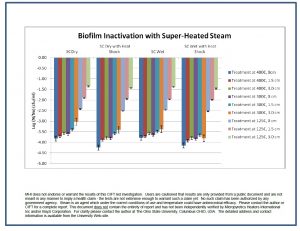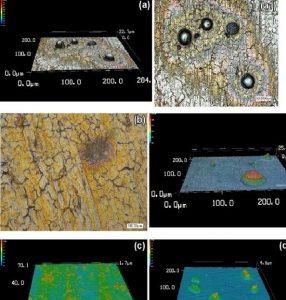Biofilms are microbial communities that are tightly attached to surfaces and cannot be easily removed. Amazingly tiny microorganisms may be protected from disinfectants by production of thick masses of cells or biofilms. Once these biofilms form, microbes within them can be resistant to disinfectants by multiple mechanisms, including physical characteristics of older biofilms, genotypic variation of the bacteria, microbial production of neutralizing enzymes, and entropic gradients within the biofilm. Bacteria within biofilms are up to 1,000 times more resistant to anti-microbials than are the same bacteria in suspension. Several biofilms, or colonies of bacteria growing on surfaces and medical devices, can inflict intractable or recurring disease. During colonization, biofilms develop characteristics and behaviors more dangerous and powerful than those of planktonic (singleton) bacteria. Biofilm communities can develop within hours. Biofilms can propagate through detachment of small or large clumps of cells, or by a type of “seeding dispersal” that releases individual cells. Either type of detachment allows bacteria to attach to a surface or to a biofilm downstream of the original community. In addition to the protection offered by the matrix, bacteria in biofilms can employ several survival strategies to evade the host and chemical attack defense systems. Even inside human bodies by staying dormant and hidden from the immune system, they may cause local tissue damage and later cause an acute infection.
Can black mold films be removed with steam?
Pdf for biofilm elimination with steam.
More Resources (with clickable links)
- https://www.cdc.gov/infectioncontrol
- Antimicrobial and Anti-Corrosive Efficacy of Inorganic Nano Porous Surfaces, Clean Technologies and Environmental Policies (CTEP), 845–857(2017)
- Nanostructured surfaces that show antimicrobial, anticorrosive, and anti-biofilm properties, KEM, Trans. Tech., Switzerland, vol. 521., pp. 1-33 (2012) (figure below is reproduced with permission from the article)
Antimicrobial trivia
- Did you know that humans have over 10 trillion cells, over 10 trillion microbial cells, several billion bacteria and bacteriophages?
- Bacteria tend to be ~ 1-10 micrometers in size and can be seen with optical microscopes.
- Viruses can range from one to 500 nanometers in size. Powerful, high magnification electron microscopes are required to image them.
- The various coronaviruses sizes are about 50 nm nanometers (including the SARS CoV-2).
- Antibodies are of the order of 10 nanometers.
- Read about anti-microbial cleaning here.
- The size of the corona virus is (~50- 150 nm) (nm-nanometers).
- The size of spikes on the virus envelope ~20 nm
- Size of pores in a good respirator ~300 nm. This is why multiple layers are used.
- With chemical even a 10 minute soak is often required to denature a virus
- With high temperature steam this could be achieved in seconds
A nanometer is 10^-9 m (^ indicates – raised to the power of)
————————————————————————————–
More Dimensional Scales of Interest
- Average Diameter of the world: 12,792 Km (Km-kilometer)
- Deepest ocean trench: ~10,994 m (m-meter)
- Highest mountain: ~ 8,850 m
- Human scale: ~1 m
- Pencil tip: ~1 mm (mm-millimeter)
- Grain of salt: ~0.1-1 mm
- Bacterium: ~1-10 micrometer (10^-6 m)
- Atoms/molecules ~0.1 nm-100nm (10^-9 m)
- Electrons: ~10^-7 nm (nanometer)
- Planck’s length (quarks): ~10^-26 nm (smallest scale that is believed to exist in space-time)



